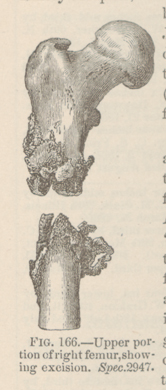Title: Fearing, J.
Source text: The Medical and Surgical History of the War of the Rebellion. (1861-65.), Part 3, Volume 2 (Washington, DC: Government Printing Office, 1883), 205.
Civil War Washington ID: med.d2e10019
TEI/XML: med.d2e10019.xml
CASE 417.—Private J. Fearing, Co. G, 21st Massachusetts, aged 23 years, received a gunshot fracture of the right thigh at Cold Harbor, June 3, 1864. He was admitted to the field hospital of the 1st division, Ninth Corps, where the operation of resection was performed but not recorded, and several days afterwards he was conveyed to Washington. Acting Assistant Surgeon P. O. Williams described the injury and its result, as follows: "The patient was admitted to Emory Hospital, June 7th, with compound comminuted fracture of the femur at the upper third, caused by a minié ball, which entered anterior to the femoral artery, passed backward and outward, and emerged on the opposite side. Two and a half inches of the bone had been excised the day after the injury, through an incision four inches in length. The general treatment consisted of tonics, stimulants, astringents, and generous diet. Pulley extension, sand bags, and bandages were applied to the limb and cold-water dressings to the wound. Small spiculæ of bone and a small piece of lead about the size of a pea were removed on June 30th. The patient died August 3, 1864, of exhaustion resulting from the excessive discharge of the wound and from severe diarrhœa, which had troubled him the last two weeks. The post-mortem revealed necrosis of both excised extremities, extending from one to one and a half inches. There was abundant deposit of osseous matter on the upper portion, but upon the lower part only a little was found on the posterior aspect." The upper half of the injured femur was contributed by Surgeon N. R. Moseley, U. S. V., and is shown in the cut (FIG. 166).
